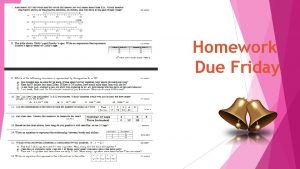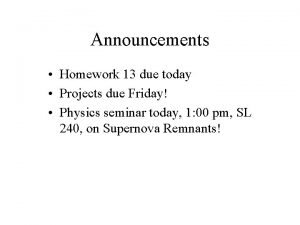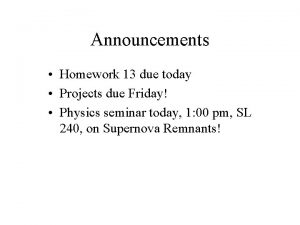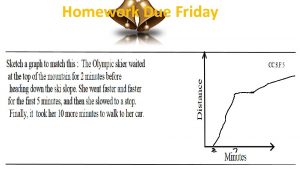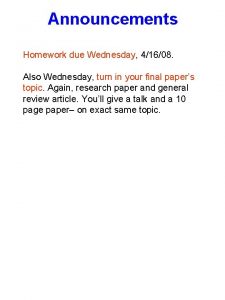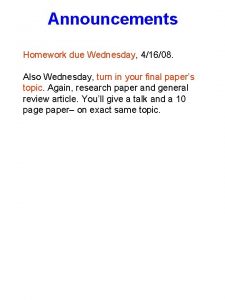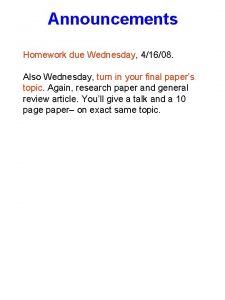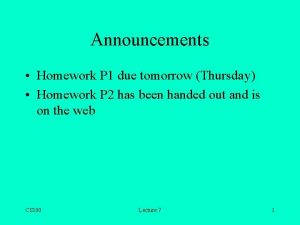Announcements Homework 13 due Wednesday Projects due Friday














- Slides: 14

Announcements • Homework 13 due Wednesday • Projects due Friday • No office hour tomorrow (Tuesday) at 10 am; I will be available after 1 pm

The Cosmic Background Radiation 27 November 2006

Today: • The cosmic background radiation – Discovery – Explanation – Detailed features

Summary of Cosmological Facts • The universe is expanding: the galaxies are gradually moving apart from each other (on average). • About 13 - 14 billion years ago, everything that we see would have been in about the same place. • By looking far enough out into space, we can look back into time and see what the universe was like 10 billion years ago: quasars were common; galaxies were smaller and bluer. • What do we see when we look still further back in time?

Hubble Deep Field

What about longer wavelengths?

The Cosmic Background Radiation • Faint microwave (and infrared) static that comes from all directions, discovered by accident in 1965. • Most intense at wavelengths of about 1 mm, but first discovered at longer wavelengths (few cm). • What is it? Light from when the universe first cooled enough to become transparent (3000 K), redshifted 1000 -fold as the universe has expanded. • What is its spectrum? • Is it perfectly uniform?

CBR Spectrum (COBE satellite, 1990) Nearly perfect thermal spectrum, T = 2. 735 K

Map of the background radiation False color! COBE satellite Hotter by 1 part in 770 toward Leo; cooler by 1 part in 770 toward Aquarius. Conclusion: We’re moving toward Leo at 1/770 the speed of light (390 km/s), with respect to the average motion of the rest of the stuff in the observable universe.

More detailed maps

Our best picture of the early univese After subtracting out the effect of our motion and the foreground radiation from our galaxy, we’re left with tiny variations of 1 part in 100, 000. These are slight variations in the density of the hot gases that filled the early universe!

A cartoon view of the Observable Universe Galaxy Dark era Quasar Background radiation (3000 -degree ionized gas)

How big is the universe? • The limit to how far we can see is a limit in time, not space: We can’t see galaxies from before there were galaxies, and we can’t see anything from before the universe became transparent to light. • How big is the whole universe? We have no idea, but most theorists would guess that it’s much larger than what we can see.

The Cosmic Background Radiation • Each cubic meter of space contains about 400 million photons of low-energy background radiation. • Compare the density of ordinary matter, which on average is only about one atom per cubic meter. • In the early universe, the densities would have been much higher, but still there would have been a few hundred million photons for every proton or neutron. • On Wednesday we’ll extrapolate back even further…
 Homework is due on friday
Homework is due on friday Homework is due on friday
Homework is due on friday Monday tuesday wednesday thursday friday calendar
Monday tuesday wednesday thursday friday calendar Monday tuesday wednesday thursday friday saturday sunday
Monday tuesday wednesday thursday friday saturday sunday Monday wednesday saturday
Monday wednesday saturday Homogenous
Homogenous Fahrenheit 451 pages
Fahrenheit 451 pages Pvu announcement
Pvu announcement Kluver bucy syndrome
Kluver bucy syndrome R/announcements!
R/announcements! General announcements
General announcements David ritthaler
David ritthaler Homework oh homework i hate you you stink
Homework oh homework i hate you you stink Jack prelutsky homework oh homework
Jack prelutsky homework oh homework Parts of a poem
Parts of a poem

